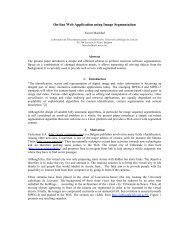motion estimation and compensation for very low bitrate video coding
motion estimation and compensation for very low bitrate video coding
motion estimation and compensation for very low bitrate video coding
Create successful ePaper yourself
Turn your PDF publications into a flip-book with our unique Google optimized e-Paper software.
24 Chapter 1. Digital Video Coding at Very-Low BitRate<br />
of pels on the image border is then reproduced (<strong>for</strong> more details,<br />
see Section 2.5.1).<br />
Arithmetic <strong>coding</strong> [60]: instead of Hu man codes [38], a more<br />
sophisticated entropy <strong>coding</strong> can be used.<br />
Advanced prediction mode: if necessary, a <strong>motion</strong> vector can<br />
be assigned to e<strong>very</strong> 8 8 block. In addition, the <strong>motion</strong> reconstruction<br />
is achieved with overlapping (cf. Section 2.5.2).<br />
PB-frames: a PB-frame consists in two pictures being coded as<br />
one unit. A predicted (P) frame is a normal inter-coded one, while<br />
a bi-directionally predicted (B) frame is computed on the basis of<br />
both the previous frame <strong>and</strong> the next P frame (which is located in<br />
the future of B along the time axis).<br />
1.4.1.4 Future Improvements: H.263+<br />
Thanks to its ne tuning, H.263 already achieves <strong>very</strong> good results,<br />
combined with <strong>low</strong> complexity <strong>and</strong> fast computation. A software coder<br />
able to treat 5 frames of 144 176 pels per second <strong>and</strong> a decoder<br />
working faster than 30 frames=s are provided by Telenor Corp. at<br />
http://www.nta.no/brukere/DVC/.<br />
Moreover Bjontegaard [9] made a few improvements that are to be added<br />
to the existing st<strong>and</strong>ard in order to de ne a new one: H.263+.<br />
1.4.2 \COMIS", the UCL Approach<br />
Initially developed by M.P. Queluz, B. Simon <strong>and</strong> B. Macq in the context<br />
of the European COST 211ter research group [112], <strong>and</strong> further rened<br />
by C. Devleeschouwer, T. Delmot, X. Marichal <strong>and</strong> B. Macq [70],<br />
the UCL has proposed an original scheme <strong>for</strong> VLBR <strong>video</strong> <strong>coding</strong> in<br />
which spatial in<strong>for</strong>mation <strong>and</strong> temporal changes are encoded using similar<br />
tools: binary trees are used to transcribe a multiscale decomposition<br />
of the in<strong>for</strong>mation, which explains the name of the algorithm: \COding<br />
on Multiscales Image Sequences" (COMIS). A complete description of<br />
the algorithm may be found in [65, 68].<br />
Designed as a VLBR codec, COMIS tries to combine the cheap blockbased<br />
picture description provided by the multiscale representation <strong>and</strong><br />
a region-oriented underst<strong>and</strong>ing of the pictures in order to improve the<br />
analysis <strong>and</strong> the reconstruction stages. Figure 1.4 presents the codec





